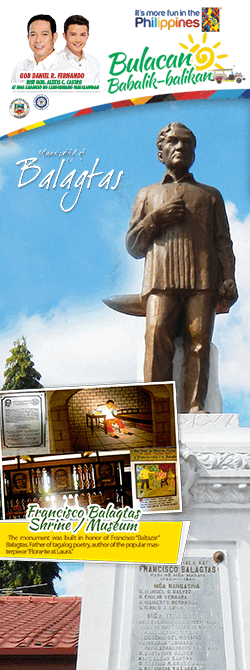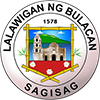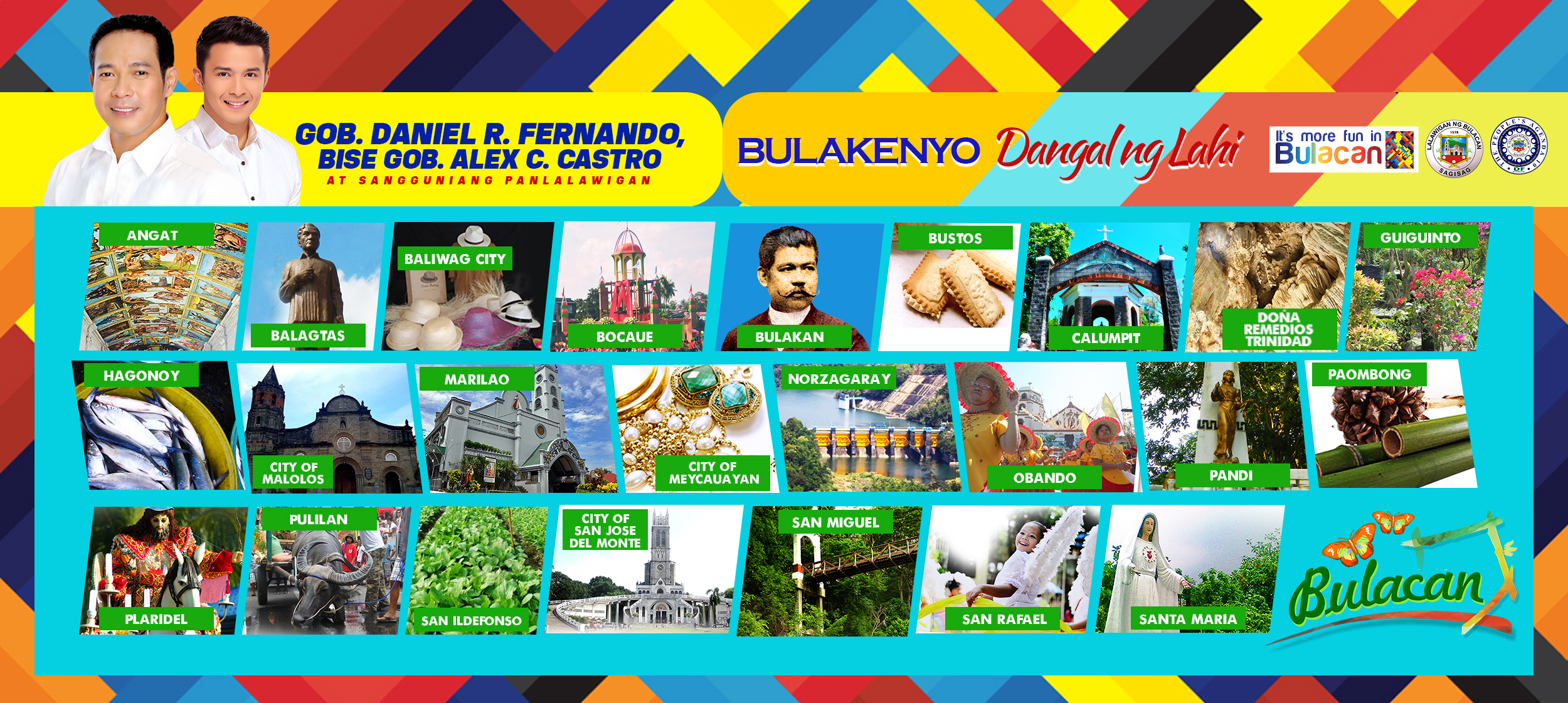
| Thirty kilometers North of Manila is the town of Balagtas (formerly Bigaa), which has nine barrios. The town is shaped like a pentagon, bounded by four towns; on the South by Bocaue, on the Month by Plaridel on the East by Pandi, on the West by the towns of Bulacan and Guiguinto. The McArthur Highway bisects the municipality of Balagtas as this national road cuts northward to the Ilocos region. At the southern approach of the town from Manila is a modern, first class concrete bridge that crosses the Balagtas River. The river, navigable by banca and motor boats, empties into Manila bay after snaking through the town of Bulacan to the West which provides Balagtas' townsfolk with fish, shrimp, and other fresh water food.
At the foot of the bridge, along the highway towards the North, is the town hall. In front of the town hall is spacious park where the monument of it hero, Francisco Balagtas, fondly known as Balagtas, is located. (Balagtas as acclaimed as the father of Tagalog poetry). Surrounding the town hall are Spanish colonial-type houses that vividly show the influence of the former invaders. Two hundred meters from the municipal hall is the famous and historical barrio in Panginay, the birthplace of Francisco "Balagtas" Baltazar, the town's most prominent son and from whom the town got is name. For whom also "Balagtasan", a form of debate in versified Tagalog, was named. In reverence to the hero's deeds, the official name of Bigaa was changed Balagtas through the legislative act sponsored by the late Congressman, Teodulo Natividad. In 1946, the Historical Society of the Philippines placed a market at the birthplace of Balagtas, which reads: "Here in Barrio Panginay, Bigaa, Bulacan, Francisco Baltazar (Balagtas) was born on April 2, 1788. Son of Juan Baltazar and Juana dela Cruz, he is the father of Tagalog dialect and the author of the deathless "Florante at Laura". Jose Burgos, Jose Rizal, Mariano Ponce, Macario Adriatico, Epifanio Delos Santos, Rafael Palma and other illustrious sons of the nation recognize and honor Francisco "Balagtas" Baltazar. He died in Udyong, Bataan on February 20, 1862." Despites its proximity to Manila, Bigaa did not become a town until the later part of the 18th century. During the Philippine revolution, barrio Kakarong, then part of Bigaa (now apart of Pandi), was the scene of many bitter encounter between the "insurrectos" and the "Guardia civiles". Many people died, further decimating the town, which has suffered from a cholera epidemic and nearly wiped out the population 20 years before. When the Americans established civil government in 1902, Bigaa and nearby Bocaue were combined to form a town with the latter as the seat government. In 1911, however, Bigaa was separated from Bocaue, and to it was added the town of Pandi, which became one of Bigaa's barrios. In 1946, shortly after the Philippines gained political freedom from the United States, Pandi by virtue of a legislative fiat was given a municipal charter of its own, distinct and apart from Bigaa. |
Fast Facts
Physical and Socio-Political
Land Area: 2,866 has
No. of Barangays: 9
Population (2015): 73,929
Commerce and Industry
Major Industries:
Farming, Furniture, Garments, Rice Milling, Service Industries, Food Processing, Trading
Major Products:
Furniture/Agricultural Products
Political Subdivision
Balagtas is politically subdivided into the following 9 barangays:
1. Borol 1st
2. Borol 2nd
3. Dalig
4. Longos
5. Panginay
6. Pulong Gubat
7. San Juan
8. Santol
9. Wawa (formerly Poblacion)
Contact Information
Municipal Officials:
Mayor Eladio E. Gonzales, Jr.
Vice Mayor Ariel C. Valderama
Mailing Address:
Ms. Hilda C. Gonzales (OIC)
Municipal Planning and Development Office
Municipal Government of Balagtas, Bulacan
Balagtas, Bulacan 3016 Philippines
Contact Nos:
Tel. No.: +63(44) 693-7950 (Mayor's Office); 693-2242 & 46 (Trunkline);
local 105 / 693-9001 (MPDC)
|
|||




